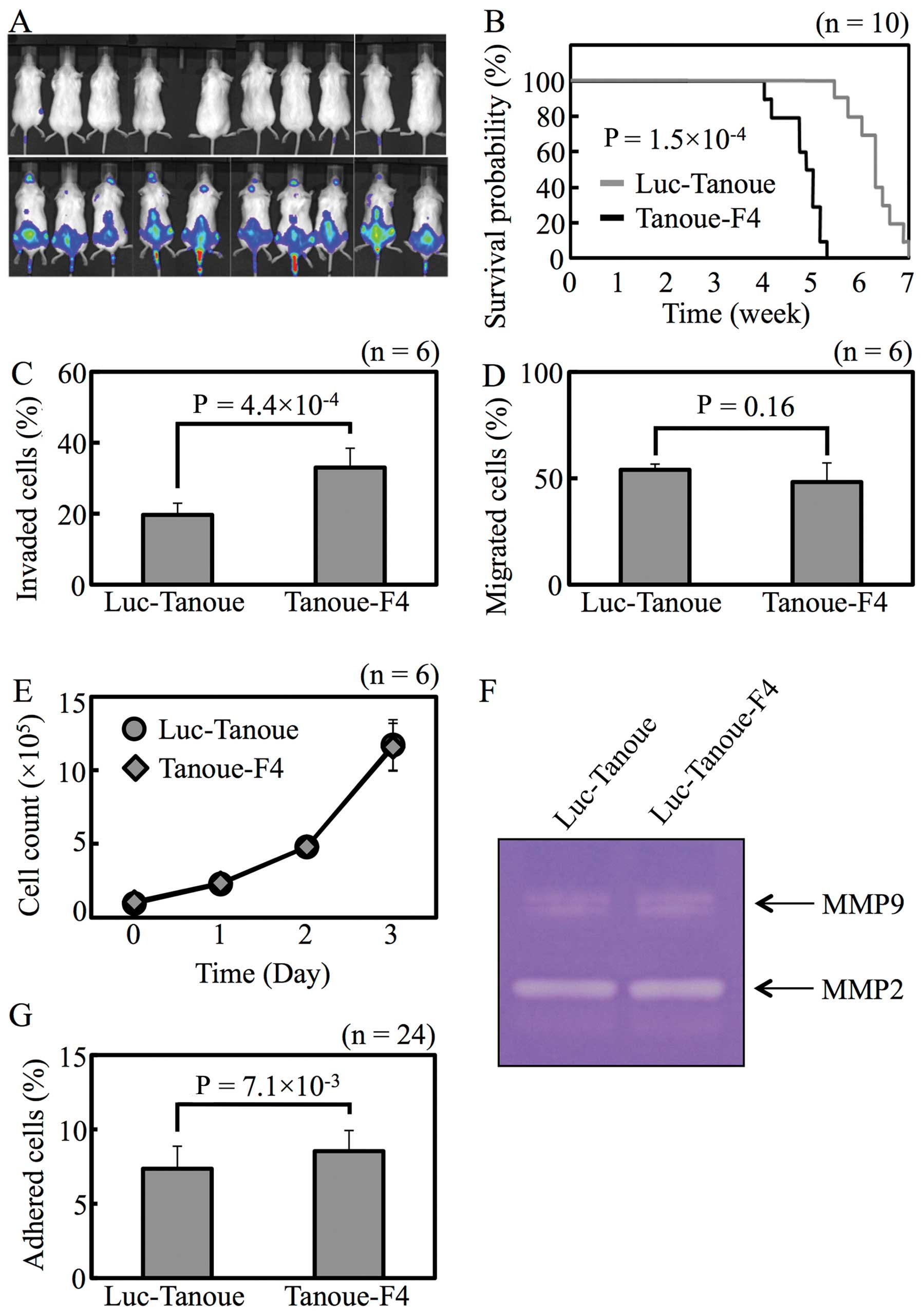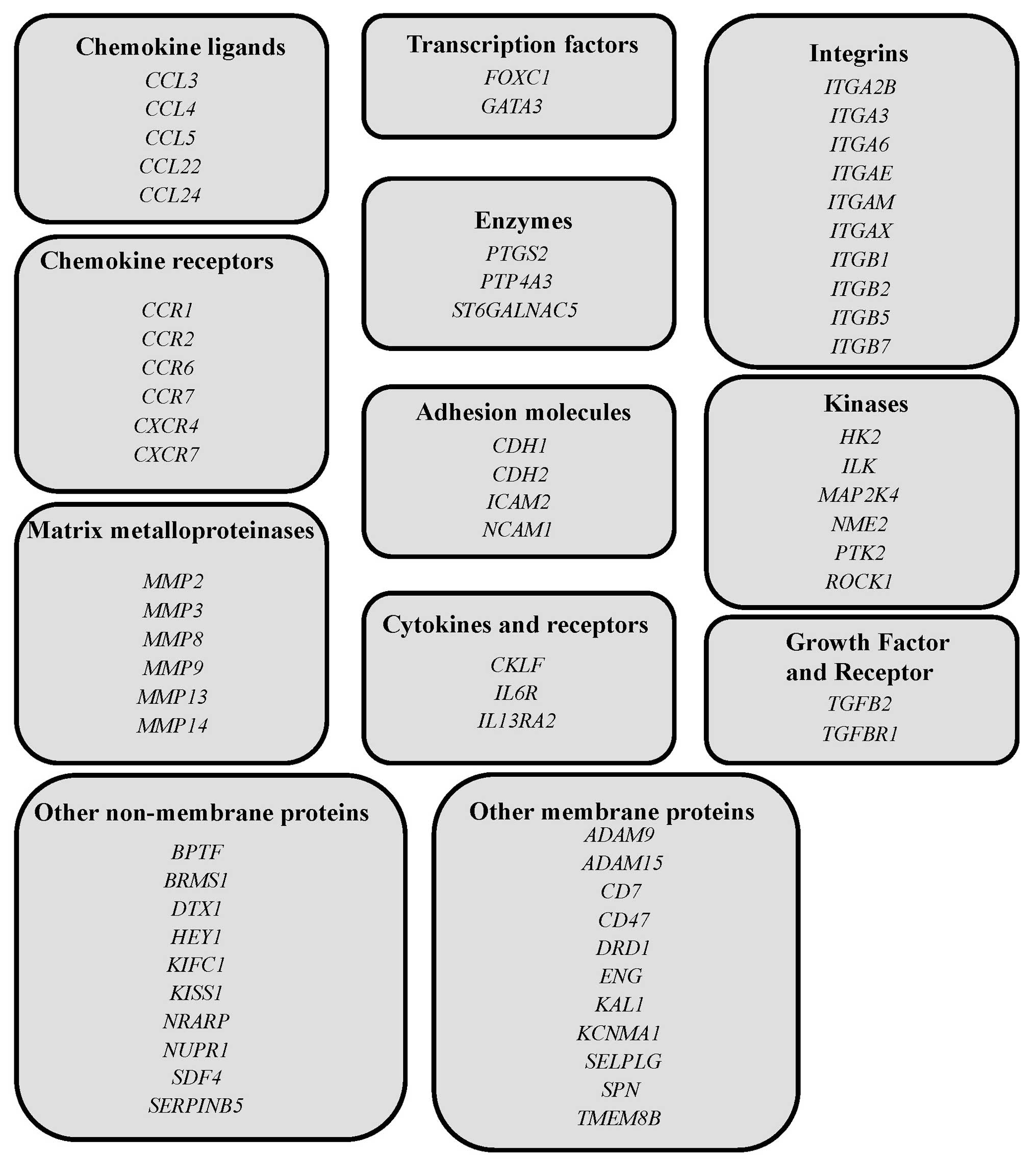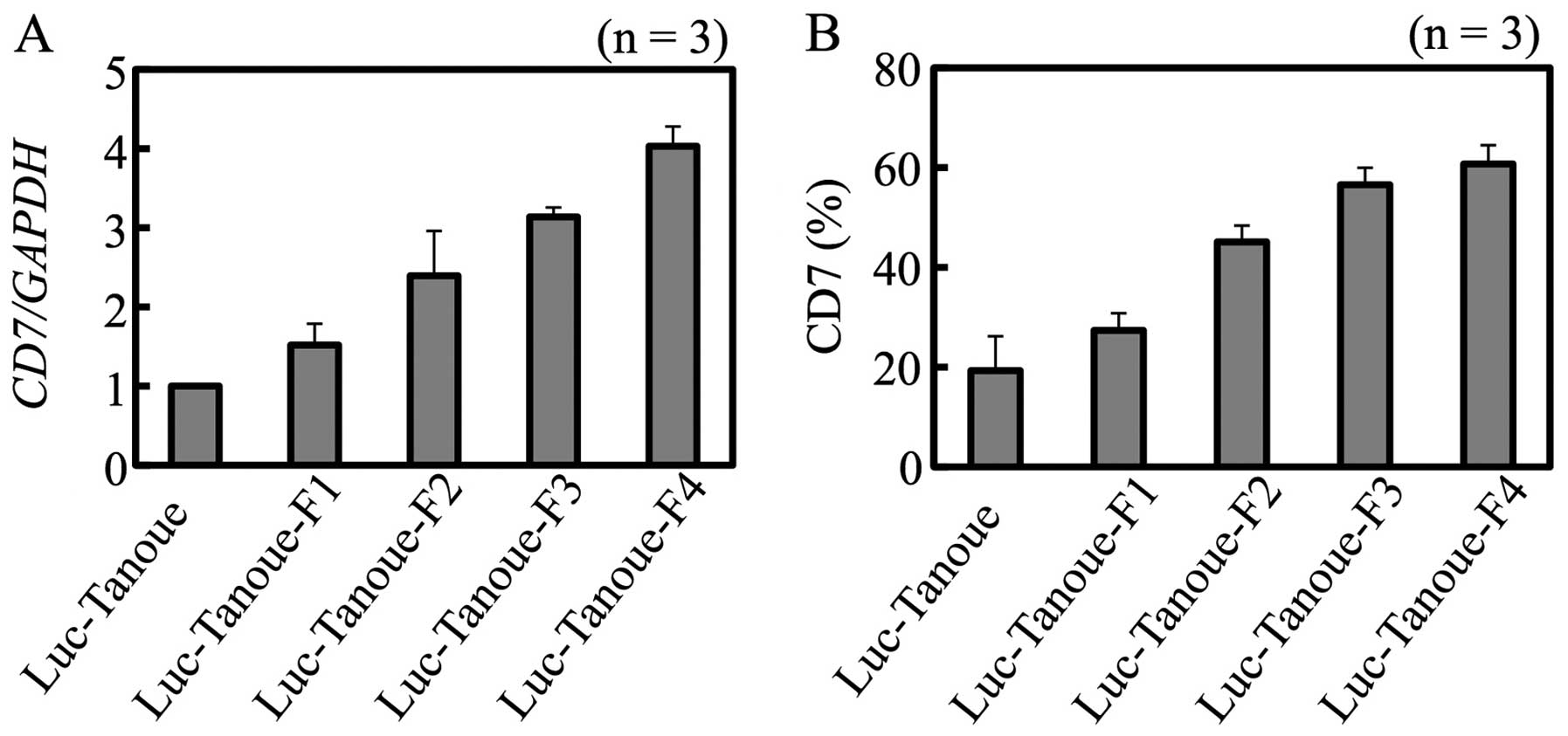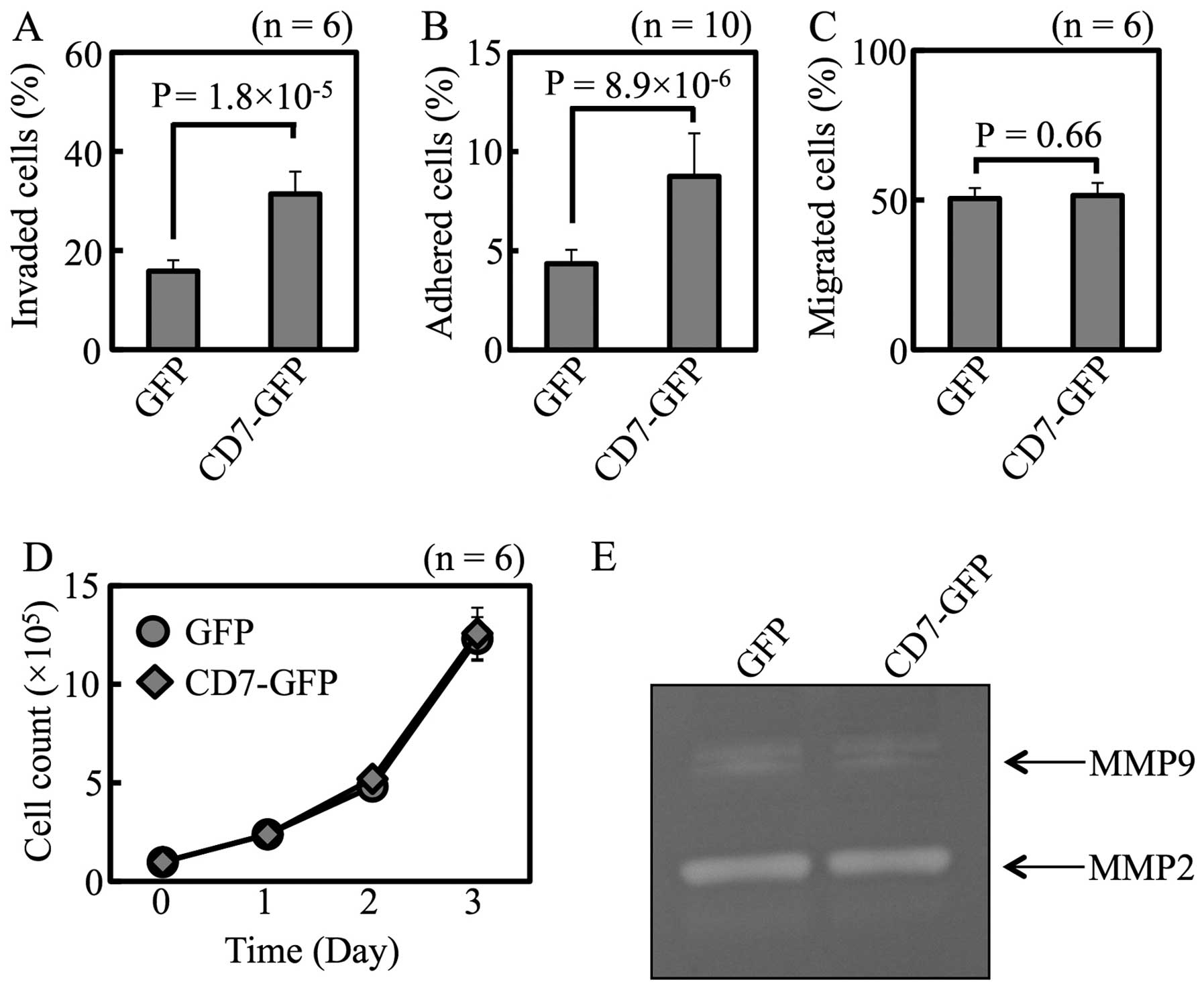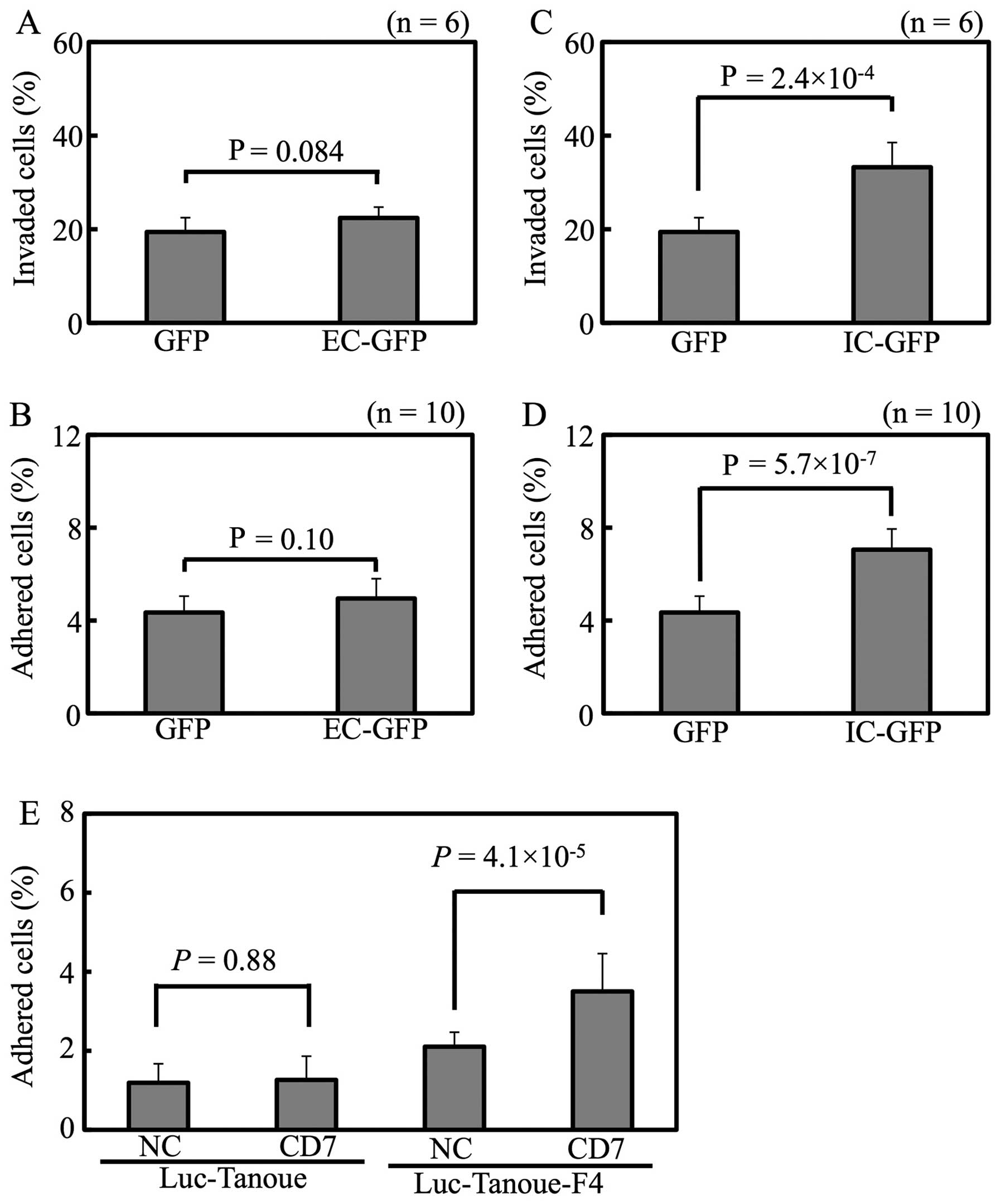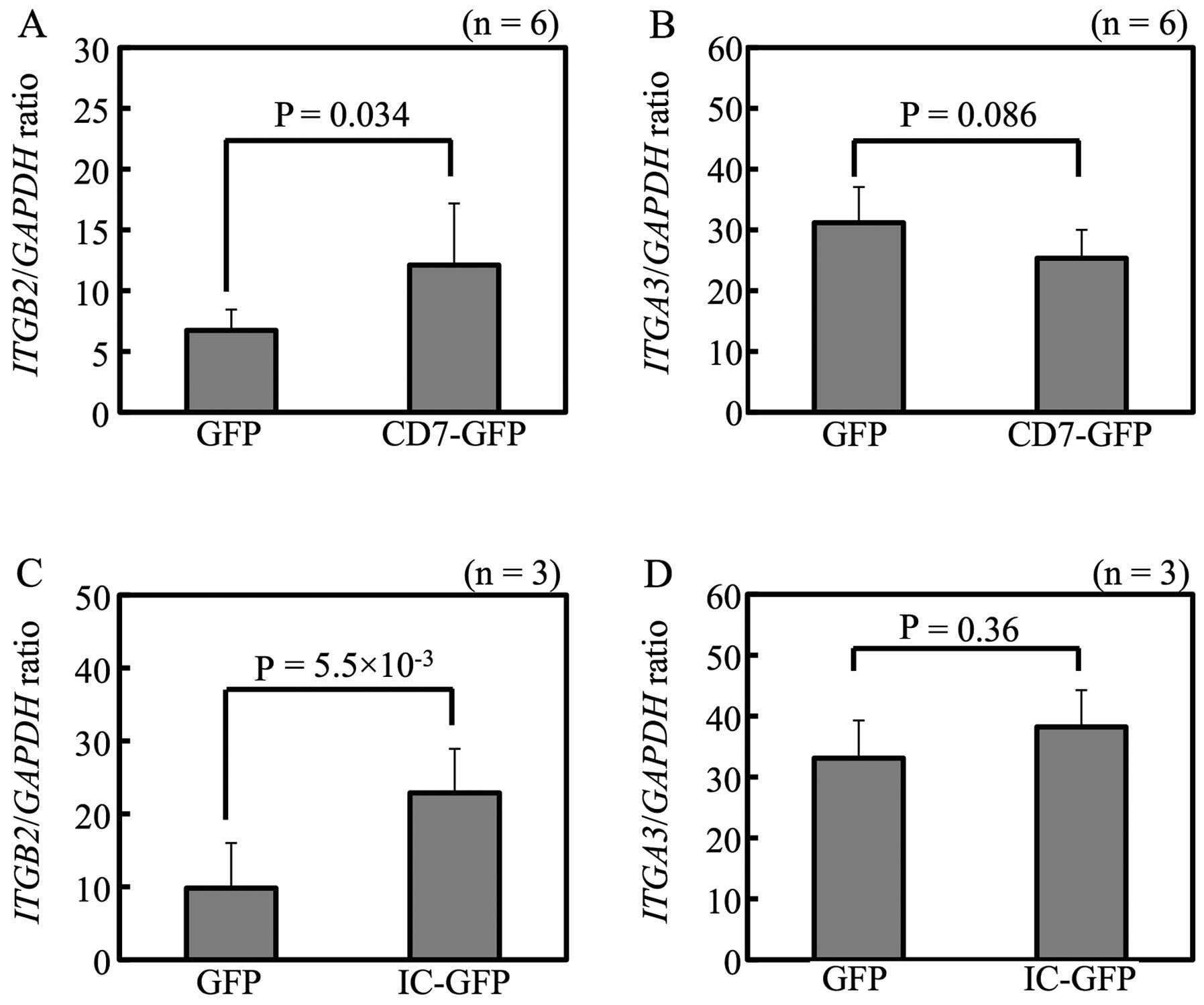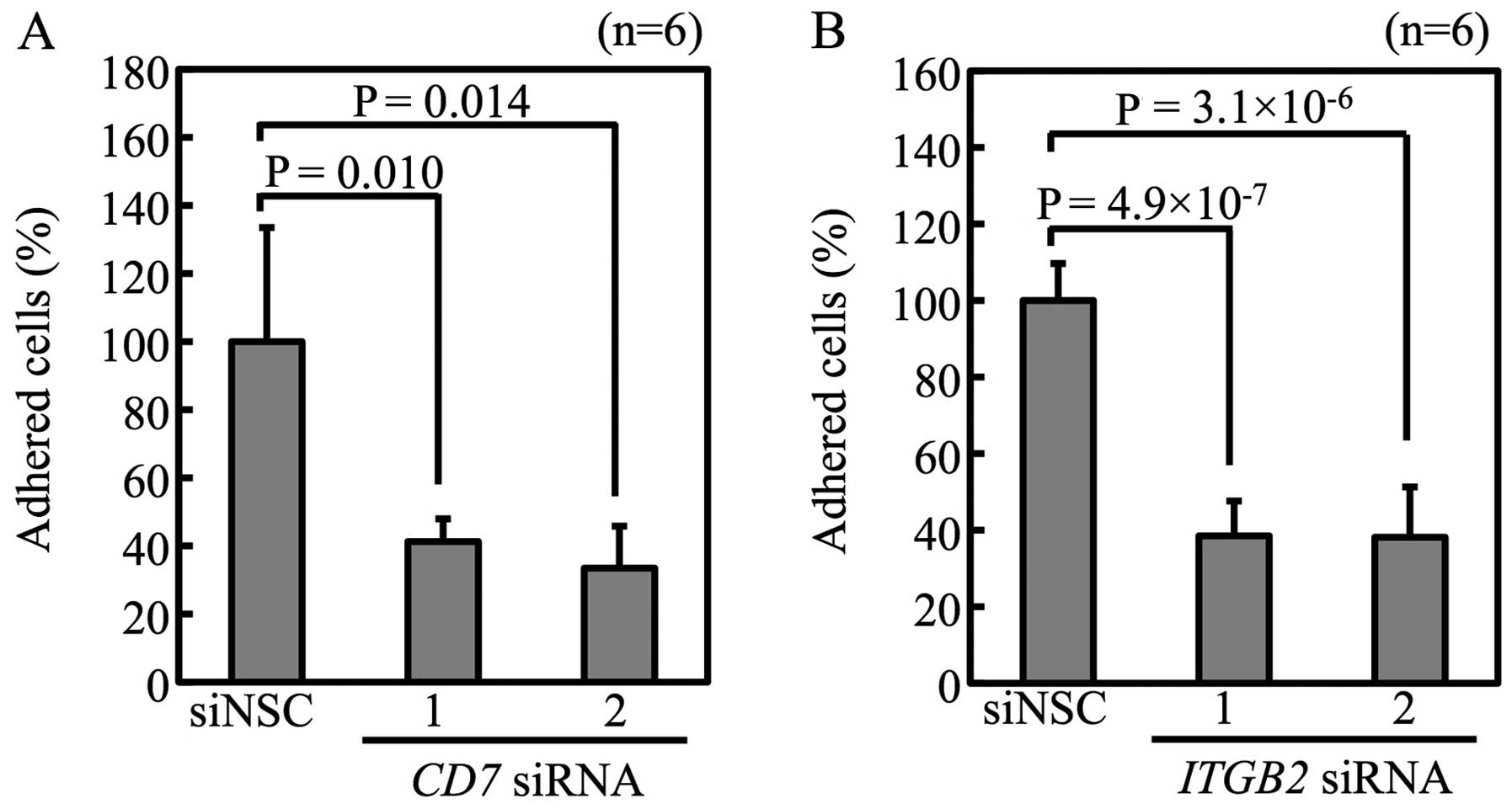CD7 promotes extramedullary involvement of the B-cell acute lymphoblastic leukemia line Tanoue by enhancing integrin β2-dependent cell adhesiveness
- Authors:
- Published online on: June 11, 2014 https://doi.org/10.3892/ijo.2014.2492
- Pages: 1073-1081
Abstract
Introduction
Acute lymphoblastic leukemia (ALL), a malignant disorder of lymphoid progenitor cells, arises mainly in children and adolescents, and is the most common malignancy in these generations (1). Despite recent advances in the treatment of ALL, 20% of the patients cannot be cured even for those types of ALL with the best prognosis (2). Older age, higher leukocyte count, hypodiloidy, t(9;22), t(4;11), and extramedullary involvement (EMI) are the factors that relate to poor prognosis (3,4). EMI not only associates with poor prognosis but also induces painful symptoms. At initial diagnosis, approximately 30–50, 8, 2.5–5 and 0.6% of patients show infiltration of leukemic cells into the liver, mediastinum, central nervous system (CNS), and testis, respectively (4–6). Moreover, solitary CNS or testicular relapse is experienced in 20.9 or 5.3% of relapsed patients, respectively (7). The T-cell immunophenotype, hyperleucocytosis, the Philadelphia reciprocal translocation between chromosome 9 and 22, and the presence of leukemic cells in the cerebrospinal fluid are factors that predict extramedullary relapse (3,5,7).
ALL is a clonal disorder that is characterized by heterogeneous subpopulations of cells with different malignant behavior. The dissemination of leukemic cells (also referred to as metastasis in the context of solid tumors) is not a random event. Instead, this is a process destined by characteristic molecular events, with certain tumor cells having a specific affinity for the microenvironment (8,9). In this context, significant effort has been devoted to finding molecules that direct leukemic cells to extramedullary organs. Clinically, overexpression of CXCR4, interleukin-15, CCR9, CD56, CD103, matrix metalloproteinase-2 (MMP-2), and MMP-9, or underexpression of intracellular adhesion molecule 1 (ICAM1) have been correlated with EMI (8,10–15). Experimental evidence suggested that Notch1 controls CCR7 expression and guides leukemic cells to CNS in vivo (16). Mass spectrometry revealed that leukemic cell lines with a higher invasiveness expressed RAC2 (17). Recently, Castro et al demonstrated that 5T4 oncofetal antigen enhances invasiveness of leukemic cell lines in vitro and in vivo (18).
Although an increasing number of studies are reporting on searches for molecules that associate with EMI of ALL, no study has used global gene expression analysis to compare leukemic clones with high and low invasiveness derived from the same cell line. In this study, we used the B-ALL cell line Tanoue to obtain a cell line with high invasiveness by in vivo selection and compared the gene signature with the parental cells.
Materials and methods
Cell line
The human B lymphoblastic leukemia cell line Tanoue was obtained from the Riken BioResource Center (Tsukuba, Japan). Tanoue was cultured in RPMI-1640 (Lonza, Basel, Switzerland) supplemented with 10% heat-inactivated fetal bovine serum (FBS; Hyclone, Logan, UT, USA) at 37°C in a humidified atmosphere of 5% CO.
Retroviral transfection of luciferase gene
Expression of the firefly luciferase gene was carried out as described, previously (19). Briefly, the retrovirus vector pBABE-Luc-Hygro was transfected into the packaging cell line Platinum-A (Cell Biolabs Inc., San Diego, CA, USA) using Lipofectamine 2000 (Life Technologies Inc., Gaithersburg, MD, USA) according to the manufacturer’s instructions. The supernatant was collected, and Tanoue was infected with the virus in the presence of 8 μg/ml hexadimethrine bromide (Sigma-Aldrich, St. Louis, MO, USA). Luciferase-expressing Tanoue (Luc-Tanoue) cells were selected by exposure to 250 μg/ml of hygromycin B (Wako Pure Chemical Industries, Tokyo, Japan) for 1 week.
Non-invasive in vivo imaging and selection of highly infiltrative leukemic cell line
The study protocol was approved by the Animal Ethics Committee of Sapporo Medical University (no. 09-003). The tail vein of NOD/SCID mice (female, 5-week old) were injected with 1×106 Luc-Tanoue in 0.1 ml RPMI. Bioluminescence signals were monitored weekly using the IVIS Lumina II (Caliper Life Sciences, Hopkinton, MA, USA) after isoflurane anesthesia was administered to the animals. Before imaging, each mouse was injected with 0.15 ml luciferin (20 mg/ml potassium salt; Promega, Madison, WI, USA), intraperitoneally. To establish a highly infiltrative leukemic cell line, the mice were monitored until leukemic cells infiltrated the CNS. Thereafter, leukemic cells in the brain was harvested, their culture in vitro generated the line the Luc-Tanoue-F1. Repetition of this selection cycle 4 times generated Luc-Tanoue-F4 line.
In vitro cell invasion and migration assay
Cells were seeded in the upper chamber of BD BioCoat Matrigel Invasion Chamber (8-μm pore size; BD Bioscience, San Jose, CA, USA) at a density of 1×106 cells per well in 0.5 ml RPMI-1640 with 0.1% FBS and 0.5 ml of RPMI-1640 containing 1% FBS was added to the lower chamber. Plates were incubated for 48 h at 37°C in a humidified atmosphere (5% CO) and cells that migrated into the lower chamber were enumerated with an XE-5000 hemocytometer (Sysmex, Kobe, Japan). The percentage of invasive cells was expressed as a percentage of total cells.
Cell migration assay was performed as described above, except that the Transwell chamber (8-μm pore size; Corning, Corning, NY, USA) was used as the assay plate, and the plates were incubated for 24 h.
Cell proliferation assay
Cells were seeded in 24-well plates at a density of 1×105 cells per well in triplicate. Plates were incubated at 37°C in a humidified atmosphere (5% CO) and cell numbers were determined using an XE-5000 hemocytometer (Sysmex) at the time-points indicated in each experiment.
In vitro cell adhesion assay
Flat-bottomed 96-well plates (Corning) were coated with Matrigel (BD Bioscience) diluted with RPMI-1640 to 100 ng/μl, seeded with 2×105 cells, incubated for 2 h at 37°C, washed twice before measuring the number of attached cells using the Cell Titer-Glo™ Luminescent Cell Viability assay (Promega), according to the manufacturer’s instructions. The level of ATP-derived luminescent signal was measured using a Veritas™ Microplate Luminometer (Promega). Adhered cells are described as a percentage of total cells seeded.
Zymography
MMP-2 and MMP-9 activity of cultured media was assessed by gelatin zymogram (Life Technologies Inc.) according to the manufacturer’s instructions. Briefly, cells were cultured in RPMI-1640 without FBS for 24 h, after which 10 μl of the media was diluted 1:1 with Tris-glycine SDS sample buffer and separated by electrophoresis on a 10%-Novex Zymogram (gelatin) gel. The gels were incubated in Zymogram Renaturing buffer for 30 min at room temperature, equilibrated with Zymogram Developing buffer and incubated overnight at 37°C. The gels were stained with Coomassie brilliant blue and MMP activity was detected as clear bands against a dark background.
Quantitative reverse transcriptase-polymerase chain reaction
Expression of CD7 mRNA was determined by quantitative reverse transcriptase-polymerase chain reaction (RT-PCR). Total RNA was isolated using the RNeasy Mini Kit (Qiagen), according to the protocol provided by the manufacturer. The cDNA was synthesized using TaqMan Reverse Transcription reagents (Applied Biosystems, Foster City, CA, USA). The gene-specific primers and fluorescent hybridization probes used in the quantitative PCR were as follows: CD7 forward primer, 5′-TCGGACACTGGCACCTACAC-3′; reverse primer, 5′-TGCCATCCTTGGGACTGTTC-3′; and probe, 5′-TGCCAGGCCATCACGGAGGTCAAT (TAMRA)-3′. Expression level of CD7 was compared to the level of GAPDH, which was determined using the GAPDH control reagents (Applied Biosystems). For ITGA3 and ITGB2, the primers and probes were purchased from Applied Biosystems.
Flow cytometric analysis and cell sorting
Surface immunophenotyping and cell sorting was performed using the EPICS XL-MCL flow cytometer (Beckman Coulter, Fullerton, CA, USA) and FACS Aria II cell sorter (Becton-Dickinson). Fluorescein isothiocyanate (FITC)-conjugated anti-CD7 antibody (6603824) was purchased from Beckman Coulter.
Microarray analysis
Global gene expression profiling was carried out by Hokkaido System Science (Sapporo, Japan) using Agilent RNA Spike-In Kit for One color and Agilent SurePrint G3 Human GE 8x60K Microarrays following the Agilent one-color microarray-based gene expression analysis protocol (Agilent Technologies, Santa Clara, CA, USA). The slides were scanned with an Agilent Technologies Microarray Scanner and the image data was processed using Agilent Feature Extraction software, version 10.7.3.1. The gene expression levels were compared after global normalization.
Construction of CD7 expressing vectors and the transfection procedure
Full length CD7 was amplified using 5′-GCTAGCAACATGGCCGGGCCTCCGAGGCTCC-3′ and 5′-ACCGGTTGGTACTGGTTGGGGGAGGACAGC-3′ as the forward and reverse primer, respectively. Extracellular domain of CD7 was amplified using 5′-GCTAGCAACATGGCCGGGCCTCCGAGGCTCC-3′ and 5′-ACCGGTCTCGCCAGCACACACGCCACCCC-3′ as the forward and reverse primer, respectively. Intracellular domain of CD7 was amplified using 5′-GCTAGCACCATGGCGAGGACACAGATAAAGAAAC-3′ and 5′-ACCGGTTGGTACTGGTTGGGGGAGGACAGC-3′ as the forward and reverse primer, respectively. The PCR products were cloned into PCR4-TOPO vector (Life Technologies), sequenced, and the cDNA then excised by restriction digestion prior to cloning into the NheI and AgeI sites of pTurbo-GFP-N vector (Evrogen, Moscow, Russia), resulting in pTurboCD7-GFP, pTurboCD7-EC-GFP and pTurboCD7-IC-GFP. The plasmids were transfected into cells using Lipofectamine 2000 (Invitrogen) according to the manufacturer’s protocol. GFP-positive cells were selected using FACS Aria II cell sorter (Becton-Dickinson).
Silencing of CD7 and ITGB2 by short interfering RNA (siRNA
Stealth siRNAs against CD7 (HSS101524, HSS190108) and ITGB2 (HSS105563, HSS105564) were purchased from Life Technologies. Non-silencing siRNA control was purchased from Applied Biosystems. All siRNAs were transfected into cells by electroporation, using Amaxa cell line Nucleofector Kit T (Lonza, Gaithersburg, MD, USA) Nucleofector II (Lonza) and the program C-005, according to the manufacturer’s instructions.
Statistical analysis
Statistical analysis of the data was conducted using Microsoft Excel®. Statistical significance was evaluated with the Student’s t-test.
Results
Selection of a highly invasive leukemic cell line
The highly invasive cell line Luc-Tanoue-F4 was obtained by 4 rounds of in vivo selection. To confirm that Luc-Tanoue-F4 is more invasive than Luc-Tanoue, the cells were injected into the tail vein of non-obese diabetic/severe combined immunodeficient (NOD/SCID) mice, and EMI was monitored non-invasively in vivo. After 2 weeks, none of NOD/SCID mouse injected with Luc-Tanoue showed apparent CNS involvement; however, 9 of 10 mice injected with Luc-Tanoue-F4 revealed involvement of the brain or olfactory bulb (Fig. 1A). Mean survival was shorter in mice injected with Luc-Tanoue-F4 than Luc-Tanoue (Fig. 1B; 34.0±3.0 vs. 44.0±3.4 days, P=1.5×10−4).
Luc-Tanoue-F4 was more invasive than Luc-Tanoue in vitro (Fig. 1C). Cell migration, proliferation, adhesion, and protease activity, all of which are the factors that affect cell invasiveness, were characterized in vitro. There were no differences between the 2 lines in terms of cell migration (Fig. 1D), proliferation (Fig. 1E), or protease activity (Fig. 1F). Cell adhesion was the only factor that differed between Luc-Tanoue and Luc-Tanoue-F4 (Fig. 1G).
CD7 expression is higher in Luc-Tanoue-F4 than Luc-Tanoue
Next, Luc-Tanoue and Luc-Tanoue-F4 were subjected to microarray analysis to compare gene-expression signatures. When the cut-off value of gene expression level was set at 2-fold, 286 and 236 genes were expressed at higher and lower levels in Luc-Tanoue-F4 than Luc-Tanoue, respectively (GEO accession nos. GSE53651). Analysis of the expression of genes that relate to EMI or brain metastasis (listed in Fig. 2) indicated that CD7 showed the largest difference (4.59-fold) in transcript levels between the 2 cell lines. Levels of ITGB2 (2.17-fold) and ITGA3 (2.13-fold) transcripts were also higher in Luc-Tanoue-F4 than Luc-Tanoue.
Levels of CD7 transcripts in Luc-Tanoue and Luc-Tanoue-F1-F4 increased as the cells underwent in vivo selections (Fig. 3A). Analysis of CD7 protein abundance by fluorescence-activated cell sorting (FACS) was consistent with the result of gene expression analysis (Fig. 3B).
CD7 promotes cell invasiveness and adhesion
The CD7 protein was overexpressed as a fusion to green fluorescent protein (GFP) in Luc-Tanoue, a line that expresses CD7 at a low level. The CD7 mRNA expression level was 51.0-fold higher in CD7-GFP transfectant than in the mock-transfected cells.
When measured in vitro, both cell invasiveness (Fig. 4A) and adhesion (Fig. 4B) were higher in CD7-GFP transfectants than mock-transfectants. There were no differences in cell migration, proliferation, or protease activity between these 2 transfectants (Fig. 4C–E).
These transfectants failed to express the GFP-fusion protein in vivo. Thus, Luc-Tanoue was separated into CD7-low expressing cells (Tanoue-CD7) and CD7-high expressing cells (Tanoue-CD7) by FACS. Tanoue-CD7 showed higher levels of invasiveness and cell adhesion than Tanoue-CD7 in vitro (data not shown). Whereas all mice injected with Tanoue-CD7 showed olfactory bulb involvement, mice injected with Tanoue-CD7 showed no apparent EMI (data not shown). These results show that CD7 enhances the invasiveness of Tanoue cells in vitro and in vivo.
CD7 intracellular domain promotes cell invasiveness and adhesion
To gain insight into the mechanism by which CD7 enhances the adhesion of leukemic cells, the intracellular and extracellular domains of CD7 were overexpressed separately in Luc-Tanoue. Whereas expression of the extracellular domain neither enhanced cell invasiveness (Fig. 5A) nor adhesiveness (Fig. 5B), the intracellular domain enhanced both cell invasiveness (Fig. 5C) and adhesiveness (Fig. 5D). Given the lack of availability of an anti-CD7 blocking antibody, Luc-Tanoue and Luc-Tanoue-F4 were stimulated with CD7-agonistic antibody; whereas the CD7-agonistic antibody enhanced adhesion of the Luc-Tanoue-F4 (which expresses a high level of CD7), it had little effect on the Luc-Tanoue (which expresses a low level of CD7) (Fig. 5E). These results show that signal transduction evoked by the intracellular domain of CD7 enhanced the cell invasiveness and adhesive capacity of Tanoue cells.
Integrin β2 mediates cell adhesion of Tanoue
To check whether CD7 regulates expression levels of ITGB2 and ITGA3, pTurbo-GFP-N, pTurboCD7-GFP and pTurboCD7-IC-GFP transfectants were analyzed. As shown in Fig. 6A and C, pTurboCD7-GFP and pTurboCD7-IC-GFP transfectants showed higher levels of ITGB2 expression than pTurboGFP-N transfectants. Transfection of pTurboCD7-GFP and pTurboCD7-IC-GFP did not increase ITGA3 expression (Fig. 6B and D). Expression level of integrin β2 was higher in Luc-Tanoue-F4 than Luc-Tanoue, confirmed by FACS (data not shown). Suppression of CD7 and ITGB2 by siRNA reduced adhesion of Luc-Tanoue-F4 (Fig. 7). These results show that CD7 and integrin β2 regulate adhesiveness of the Tanoue leukemic cell line.
Discussion
The present study revealed that CD7 promotes EMI of the B-ALL line Tanoue. To the best of our knowledge, this is the first study to show that CD7 promotes EMI by inducing integrin β2 in hematological malignancy. Comparison of the global gene expression profile of cells with different EMI potential that were all obtained from the same B-ALL cell line and found no significant increases in any of the genes previously associated with EMI, including CXCR4, IL-15, CCR9, CD103, CD56, MMP2 or MMP9; nor did it suggest that a decrease in ICAM1 expression was associated with EMI.
CD7 is a 40-kDa type-I transmembrane single-chain glycoprotein that belongs to immunoglobulin (Ig) superfamily. It is expressed on thymocytes, T cells, and natural killer (NK) cells, as well as in subpopulation of early immature B and myeloid cells (20). The extracellular domain of CD7 shares homology with the variable region of Igκ-chains and the γ-chains of T-cell receptors (21). It is thought that CD7 exists as a homodimer, and that cross-linking antibodies that recognize CD7 stimulates its downstream signaling (22). There is a YEDM motif in the intracellular domain of CD7, and phosphatidylinositol 3-kinase and tyrosine kinase play critical roles in its activation (22–25).
Physiologically, activation of CD7 augments IL-2 production by T cells (26), induces the production of granulocyte macrophage colony-stimulating factor by myeloid progenitor cells (27), stimulates IFN-γ production in NK cells (28), and regulates the capacity for adhesion in T cells (29) and NK cells (28).
Clinically, the expression of CD7 correlates with a poor prognosis for acute myeloid leukemia (30–35), non-Hodgkin’s lymphoma (36) and B-lymphoblastic leukemia (37). Moreover, CD7+, CD4−, CD8− acute lymphoblastic leukemia is reported to show poor clinical characteristics that involves extramedullary organs, including the mediastenum, skin, and CNS (38).
This study showed that CD7 induces integrin β2 (also referred to as CD18; Fig. 6A) and enhanced the capacities of leukemic cells for adhesion (Fig. 4B). Notwithstanding, there are observations that CD7 regulates the capacities of T and NK cells to adhere to extracellular matrix, there is no evidence that CD7 plays an adhesion molecule role. Together with the results shown in Fig. 5A–D that CD7-induced signaling (but not extracellular domain of CD7) enhanced the adhesive capacities of Tanoue cells, it seems possible that the induction of integrin β2 enables CD7 to promote cell adhesiveness in the Tanoue B-ALL line. These observations are consistent with previous reports that CD7-induced cell adhesion is mediated by integrin β2 (29,39).
Integrin β2 is an important adhesion molecule in leucocytes. Genetic mutations in ITGB2 results in the immunodeficiency caused by a decreased capacity of leucocytes to adhere (leukocyte adhesion deficiency) (40,41). Furthermore, integrin β2 is critically required for leucocyte extravasation (42,43). Together with our results, these observations indicate that the CD7/integrin β2 axis may contribute to extravasation during the EMI of leukemic cells.
Results of this study imply that CD7 and integrin β2 are potential molecular targets in leukemia therapy. Indeed, antibodies against integrin β2 inhibit leukemia and lymphoma dissemination in experimental models (44–46). It remains to be established whether a blocking antibody against CD7 can inhibit dissemination of leukemia.
In conclusion, CD7 promotes EMI of the B-ALL line Tanoue in an integrin β2-dependent manner. CD7 and integrin β2 are potential molecular targets in leukemia therapy.
Acknowledgements
We thank Dr S.H. Kim (National Cancer Center, Korea) for providing us with firefly luciferase expressing vector (pBABE-Luc-Hygro).
References
|
Pui CH and Evans WE: Acute lymphoblastic leukemia. N Engl J Med. 339:605–615. 1998. View Article : Google Scholar : PubMed/NCBI | |
|
Schrappe M, Nachman J, Hunger S, et al: Educational symposium on long-term results of large prospective clinical trials for childhood acute lymphoblastic leukemia (1985–2000). Leukemia. 24:253–254. 2010.PubMed/NCBI | |
|
Pui CH, Robison LL and Look AT: Acute lymphoblastic leukaemia. Lancet. 371:1030–1043. 2008. View Article : Google Scholar : PubMed/NCBI | |
|
Schrappe M, Reiter A, Ludwig WD, et al: Improved outcome in childhood acute lymphoblastic leukemia despite reduced use of anthracyclines and cranial radiotherapy: results of trial ALL-BFM 90. German-Austrian-Swiss ALL-BFM Study Group. Blood. 95:3310–3322. 2000. | |
|
Lazarus HM, Richards SM, Chopra R, et al: Central nervous system involvement in adult acute lymphoblastic leukemia at diagnosis: results from the international ALL trial MRC UKALL XII/ECOG E2993. Blood. 108:465–472. 2006. View Article : Google Scholar | |
|
Reiter A, Schrappe M, Ludwig WD, et al: Chemotherapy in 998 unselected childhood acute lymphoblastic leukemia patients. Results and conclusions of the multicenter trial ALL-BFM 86. Blood. 84:3122–3133. 1994. | |
|
Jacobs JE and Hastings C: Isolated extramedullary relapse in childhood acute lymphocytic leukemia. Curr Hematol Malig Rep. 5:185–191. 2010. View Article : Google Scholar : PubMed/NCBI | |
|
Annels NE, Willemze AJ, van der Velden VH, et al: Possible link between unique chemokine and homing receptor expression at diagnosis and relapse location in a patient with childhood T-ALL. Blood. 103:2806–2808. 2004. View Article : Google Scholar : PubMed/NCBI | |
|
Langley RR and Fidler IJ: Tumor cell-organ microenvironment interactions in the pathogenesis of cancer metastasis. Endocr Rev. 28:297–321. 2007. View Article : Google Scholar : PubMed/NCBI | |
|
Crazzolara R, Kreczy A, Mann G, et al: High expression of the chemokine receptor CXCR4 predicts extramedullary organ infiltration in childhood acute lymphoblastic leukaemia. Br J Haematol. 115:545–553. 2001. View Article : Google Scholar | |
|
Kuittinen O, Savolainen ER, Koistinen P, Mottonen M and Turpeenniemi-Hujanen T: MMP-2 and MMP-9 expression in adult and childhood acute lymphatic leukemia (ALL). Leuk Res. 25:125–131. 2001. View Article : Google Scholar : PubMed/NCBI | |
|
Mielcarek M, Sperling C, Schrappe M, Meyer U, Riehm H and Ludwig WD: Expression of intercellular adhesion molecule 1 (ICAM-1) in childhood acute lymphoblastic leukaemia: correlation with clinical features and outcome. Br J Haematol. 96:301–307. 1997. View Article : Google Scholar | |
|
Ravandi F, Cortes J, Estrov Z, et al: CD56 expression predicts occurrence of CNS disease in acute lymphoblastic leukemia. Leuk Res. 26:643–649. 2002. View Article : Google Scholar : PubMed/NCBI | |
|
Schneider P, Costa O, Legrand E, et al: In vitro secretion of matrix metalloproteinase-9 is a prognostic marker in childhood acute lymphoblastic leukemia. Leuk Res. 34:24–31. 2010. View Article : Google Scholar : PubMed/NCBI | |
|
Wu S, Fischer L, Gokbuget N, et al: Expression of interleukin 15 in primary adult acute lymphoblastic leukemia. Cancer. 116:387–392. 2010. View Article : Google Scholar : PubMed/NCBI | |
|
Buonamici S, Trimarchi T, Ruocco MG, et al: CCR7 signalling as an essential regulator of CNS infiltration in T-cell leukaemia. Nature. 459:1000–1004. 2009. View Article : Google Scholar : PubMed/NCBI | |
|
Holland M, Castro FV, Alexander S, et al: RAC2, AEP, and ICAM1 expression are associated with CNS disease in a mouse model of pre-B childhood acute lymphoblastic leukemia. Blood. 118:638–649. 2011. View Article : Google Scholar : PubMed/NCBI | |
|
Castro FV, McGinn OJ, Krishnan S, et al: 5T4 oncofetal antigen is expressed in high risk of relapse childhood pre-B acute lymphoblastic leukemia and is associated with a more invasive and chemotactic phenotype. Leukemia. 26:1487–1498. 2012. View Article : Google Scholar | |
|
Kuribayashi K, Finnberg N and El-Deiry WS: Studying p53-dependent cell death in vitro and in vivo. Methods Enzymol. 446:159–173. 2008. View Article : Google Scholar : PubMed/NCBI | |
|
Sempowski GD, Lee DM, Kaufman RE and Haynes BF: Structure and function of the CD7 molecule. Crit Rev Immunol. 19:331–348. 1999.PubMed/NCBI | |
|
Aruffo A and Seed B: Molecular cloning of two CD7 (T-cell leukemia antigen) cDNAs by a COS cell expression system. EMBO J. 6:3313–3316. 1987.PubMed/NCBI | |
|
Lazarovits AI, Osman N, Le Feuvre CE, Ley SC and Crumpton MJ: CD7 is associated with CD3 and CD45 on human T cells. J Immunol. 153:3956–3966. 1994. | |
|
Chan AS, Mobley JL, Fields GB and Shimizu Y: CD7-mediated regulation of integrin adhesiveness on human T cells involves tyrosine phosphorylation-dependent activation of phosphatidylinositol 3-kinase. J Immunol. 159:934–942. 1997. | |
|
Lee DM, Patel DD, Pendergast AM and Haynes BF: Functional association of CD7 with phosphatidylinositol 3-kinase: interaction via a YEDM motif. Int Immunol. 8:1195–1203. 1996. View Article : Google Scholar : PubMed/NCBI | |
|
Rabinowich H, Lin WC, Herberman RB and Whiteside TL: Signaling via CD7 molecules on human NK cells. Induction of tyrosine phosphorylation and beta 1 integrin-mediated adhesion to fibronectin. J Immunol. 153:3504–3513. 1994.PubMed/NCBI | |
|
Jung LK, Roy AK and Chakkalath HR: CD7 augments T cell proliferation via the interleukin-2 autocrine pathway. Cell Immunol. 141:189–199. 1992. View Article : Google Scholar : PubMed/NCBI | |
|
Hou Z, Leta E and Jung LK: Cross-linking CD7 on myeloblasts results in granulocyte-macrophage colony-stimulating factor production. Blood. 88:124–129. 1996.PubMed/NCBI | |
|
Rabinowich H, Pricop L, Herberman RB and Whiteside TL: Expression and function of CD7 molecule on human natural killer cells. J Immunol. 152:517–526. 1994.PubMed/NCBI | |
|
Shimizu Y, van Seventer GA, Ennis E, Newman W, Horgan KJ and Shaw S: Crosslinking of the T cell-specific accessory molecules CD7 and CD28 modulates T cell adhesion. J Exp Med. 175:577–582. 1992. View Article : Google Scholar : PubMed/NCBI | |
|
Del Poeta G, Stasi R, Venditti A, et al: Prognostic value of cell marker analysis in de novo acute myeloid leukemia. Leukemia. 8:388–394. 1994.PubMed/NCBI | |
|
Jensen AW, Hokland M, Jorgensen H, Justesen J, Ellegaard J and Hokland P: Solitary expression of CD7 among T-cell antigens in acute myeloid leukemia: identification of a group of patients with similar T-cell receptor beta and delta rearrangements and course of disease suggestive of poor prognosis. Blood. 78:1292–1300. 1991. | |
|
Kita K, Miwa H, Nakase K, et al: Clinical importance of CD7 expression in acute myelocytic leukemia. The Japan Cooperative Group of Leukemia/Lymphoma. Blood. 81:2399–2405. 1993.PubMed/NCBI | |
|
Saxena A, Sheridan DP, Card RT, McPeek AM, Mewdell CC and Skinnider LF: Biologic and clinical significance of CD7 expression in acute myeloid leukemia. Am J Hematol. 58:278–284. 1998. View Article : Google Scholar : PubMed/NCBI | |
|
Yumura-Yagi K, Hara J, Kurahashi H, et al: Clinical significance of CD7-positive stem cell leukemia. A distinct subtype of mixed lineage leukemia. Cancer. 68:2273–2280. 1991. View Article : Google Scholar : PubMed/NCBI | |
|
Chang H, Yeung J, Brandwein J and Yi QL: CD7 expression predicts poor disease free survival and post-remission survival in patients with acute myeloid leukemia and normal karyotype. Leuk Res. 31:157–162. 2007. View Article : Google Scholar | |
|
Yumura-Yagi K, Ishihara S, Hara J, et al: Poor prognosis of mediastinal non-Hodgkin’s lymphoma with an immature phenotype of CD2+, CD7 (or CD5)+, CD3−, CD4−, and CD8. Cancer. 63:671–674. 1989. | |
|
Hussein S, Gill KZ, Sireci AN, et al: Aberrant T-cell antigen expression in B lymphoblastic leukaemia. Br J Haematol. 155:449–456. 2011. View Article : Google Scholar : PubMed/NCBI | |
|
Kurtzberg J, Waldmann TA, Davey MP, et al: CD7+, CD4−, CD8− acute leukemia: a syndrome of malignant pluripotent lymphohematopoietic cells. Blood. 73:381–390. 1989. | |
|
Chan AS, Reynolds PJ and Shimizu Y: Tyrosine kinase activity associated with the CD7 antigen: correlation with regulation of T cell integrin function. Eur J Immunol. 24:2602–2608. 1994. View Article : Google Scholar : PubMed/NCBI | |
|
Kishimoto TK, Hollander N, Roberts TM, Anderson DC and Springer TA: Heterogeneous mutations in the beta subunit common to the LFA-1, Mac-1, and p150,95 glycoproteins cause leukocyte adhesion deficiency. Cell. 50:193–202. 1987. View Article : Google Scholar | |
|
Mathew EC, Shaw JM, Bonilla FA, Law SK and Wright DA: A novel point mutation in CD18 causing the expression of dysfunctional CD11/CD18 leucocyte integrins in a patient with leucocyte adhesion deficiency (LAD). Clin Exp Immunol. 121:133–138. 2000. View Article : Google Scholar : PubMed/NCBI | |
|
Kling D, Fingerle J and Harlan JM: Inhibition of leukocyte extravasation with a monoclonal antibody to CD18 during formation of experimental intimal thickening in rabbit carotid arteries. Arterioscler Thromb. 12:997–1007. 1992. View Article : Google Scholar | |
|
Walzog B, Scharffetter-Kochanek K and Gaehtgens P: Impairment of neutrophil emigration in CD18-null mice. Am J Physiol. 276:G1125–G11130. 1999.PubMed/NCBI | |
|
Cohen S, Haimovich J and Hollander N: Anti-idiotype x anti-LFA-1 bispecific antibodies inhibit metastasis of B cell lymphoma. J Immunol. 170:2695–2701. 2003. View Article : Google Scholar : PubMed/NCBI | |
|
Harning R, Myers C and Merluzzi VJ: Monoclonal antibodies to lymphocyte function-associated antigen-1 inhibit invasion of human lymphoma and metastasis of murine lymphoma. Clin Exp Metastasis. 11:337–342. 1993. View Article : Google Scholar | |
|
Zahalka MA, Okon E and Naor D: Blocking lymphoma invasiveness with a monoclonal antibody directed against the beta-chain of the leukocyte adhesion molecule (CD18). J Immunol. 150:4466–4477. 1993.PubMed/NCBI |



